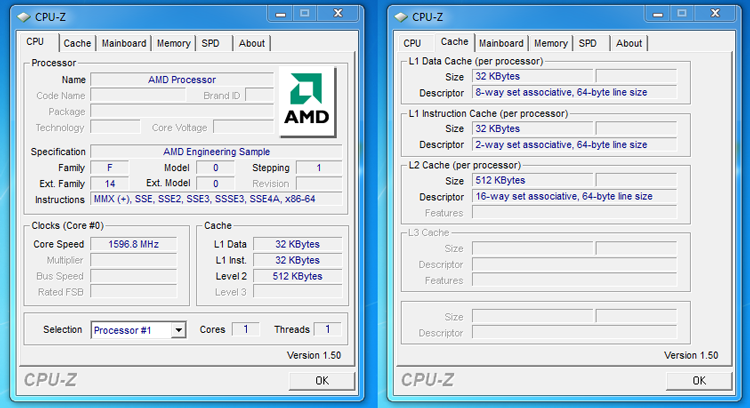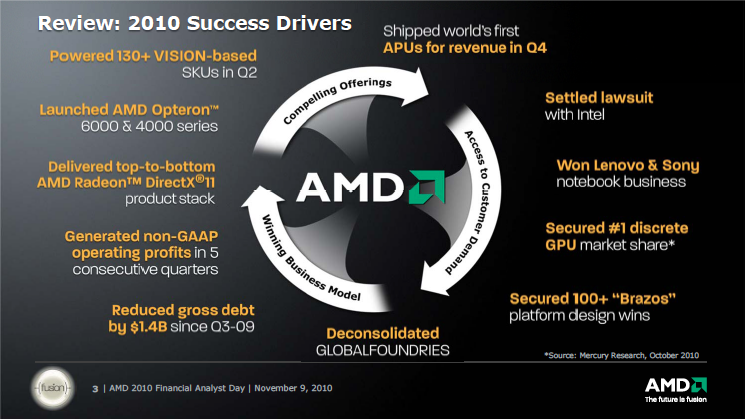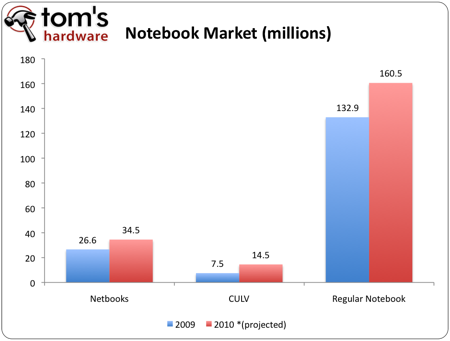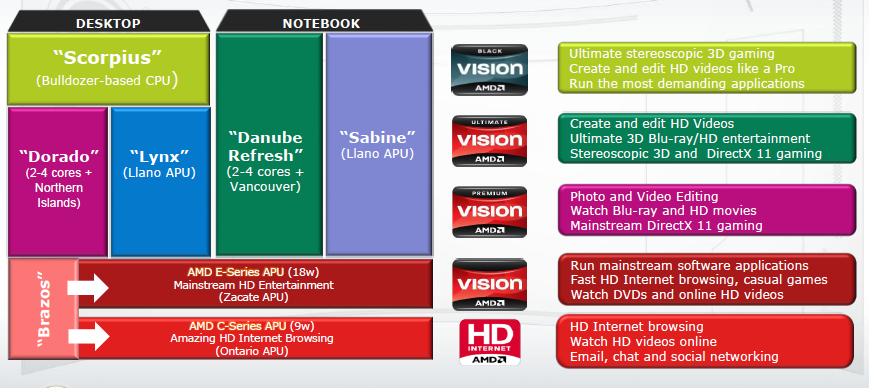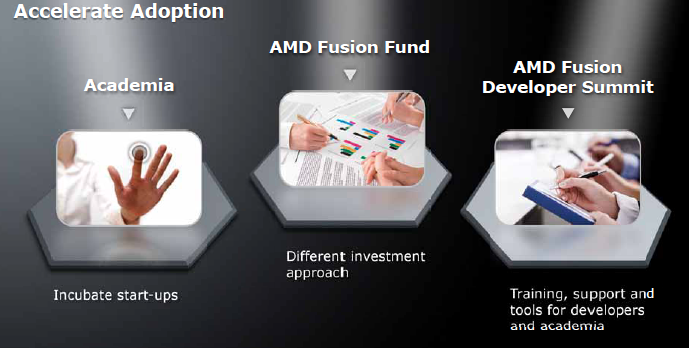AMD Fusion: Brazos Gets Previewed: Part 2, Performance
AMD gave us an opportunity to go hands-on with its upcoming Brazos platform--the only preview you'll see before this technology surfaces in retail notebooks. Is it fast enough to compete with the Nehalem-based competition, and cool enough to trounce Atom?
Final Words
Final Words
We got a very early look at Brazos, and AMD is offering something unprecedented: discrete GPU performance in a single-chip CPU/GPU package. Moreover, the company is offering impressive heat characteristics, given the complexity of what it is packing into a single die. We should clarify that AMD is aiming squarely for Intel's true blue CULV parts, by which we mean the UM Arrandales and previous generation of Core 2 Duo, Core 2 Solo, and Pentium ULV processors.
AMD is already touting over 100 Brazos design wins, which means we should see a slew of derivative notebook at CES. AMD is making a lot of noise with Brazos (specifically Zacate) as it seeks to usurp Intel in the fast-growing CULV market. However, AMD may have lost focus on the bigger picture, and that's a result of the company's performance-driven culture--to which we can certainly relate.
Of the three APUs that AMD chose to impress the press with, it understandably went for the one with a bit more of a performance edge. Unfortunately, while that does a lot for enthusiastic power users, it doesn't necessarily translate into volume or the bottom line. In general, AMD is still suffering in the mobile CPU market. Its last major successful mobile platform (in terms of sheer wins) was Puma. Those sold like hotcakes in the 15" form factor (we saw prices at $399 without rebates), but were relegated to budget product lines. AMD hardly saw any revenue beyond getting rid of legacy products.
If AMD is really dressed for success, it needs to also follow up quickly with Sabine and Ontario. As it stands, the company has an uphill battle on its hands. If you remove netbooks from the equation, 15" notebooks account for close to 50% of all notebook sales. The other 50% can be split up between 14" and 17" notebooks. For AMD to really hit a home run, we need to see how far Sabine has come along. These are numbers we have confirmed with many of our system vendor contacts, and they apply across the board, from HP, Acer, Lenovo, and Dell. Purely by the numbers, Zacate applies to roughly 7% of the current notebook market, while Ontario applies to ~15%, and mobile Llanos apply to over 75% of the notebook market.
Thin and light notebooks, all-in-one desktops, and premium netbooks are all within Zacate's target range of $500. It is a competitive solution, but the majority of laptop sales are, frankly, elsewhere. We make this point because AMD could actually underdeliver with Zacate, overdeliver with the mobile Llano and Ontario parts, and still come out on top.
So, the big question that AMD needs to address is: how much CPU performance is enough? On a netbook, it makes little sense to pay a $100 or $200 premium in order to watch 1080p video on a 10.1" screen. On a CULV or DTR notebook, this becomes more important, since you have more desktop real estate to play games and the environment conducive to enjoy multimedia. Right now, these notebooks have CPU performance to spare. AMD is pairing the Zacate APUs against the previous generation of CULV-processors from Intel: Core 2 Duo, Core Duo, and Pentium. However, according to system vendors, these notebooks will be phased out by the end of Q1'2011, which means the Zacate APUs are going to have to face off against the newer 18W UM Arrandales. These new ULV processor from Intel all carry some serious CPU horsepower.
Get Tom's Hardware's best news and in-depth reviews, straight to your inbox.
We maintain that AMD is going to need to convince system builders that good graphics performance is better than having an overabundance of processor horsepower. AMD finally achieved a CPU design win last quarter with Sony, so the only holdout is Apple. AMD needs to get this conversation going at the consumer level, because no one is really thinking this way (though they should--we see this all of the time in the desktop space, which is much more gaming-oriented). We are currently playing in an Intel sandbox, where CPU performance is still remains at the top of the agenda list.
Available (and relevant) software needs to be driven toward GPGPU if AMD really wants to claim that having acceptable CPU and GPU performance is better than having goobs of CPU horsepower. Unfortunately, we are not at that point. AMD recently started improving its developer relations. The new AMD Fusion developer "trust fund" is actually a great way to start chipping away at the current CPU-heavy mentality.
-
ares1214 Looking extremely impressive AMD, where as before you were a full gen behind, now id just say half gen. Make BD a big success, and you will most definitely get back in the game, however i doubt it would be enough to take the lead.Reply -
frederico If an Intel processor and an AMD processor were exactly the same - 9 out of 10 'normal' people would choose the IntelReply
The only people "in the know" are in the enthusiast segment of the market, which is a very small slice really.
Its a constant uphill battle for AMD, but then again, if they didn't exist, we'd all be paying through the nose for slower processors
-
I don't like when Tom's trow at us many facts from the AMD crowd to brainwash our mind. I don't like when the game is to convince the community to buy something who is not proved again.Reply
"The new AMD Fusion developer "trust fund" is actually a great way to start chipping away at the current CPU-heavy mentality." Yeas and we are also GPU-heavy mentality too!!!
-
tsnorquist killerclickWho the hell plays games on a netbook? Another spectacular fail for AMD.Reply
Probably not a lot of people, but when netbooks have the capability to play at acceptable levels for the masses, they will be great.
-
gxpbecker Nifty, an the best thing about AMD making high end competition for intel is price drops lol, if AMD can pull it off.Reply -
hannibal Even more interesting would be a tablet that can be used to play games!Reply
So it could mean that we can read e-mail, read e-books watch movies and internet pages and even play with tablet-PC. Netbook is just one step ahead... Yep it is not the same as Nvidia 460, even 350 or amd 5650 from the low end (gaming), but the resolution would be smaller, so it would be possible.
Let see what we get when this is really out.
All in all it gives people a choice. Need more CPU and very rarely GPU power... take intel... If you don't need so much CPU power, but need GPU power chose AMD. It's good to have altenatives!
-
K2N hater fredericoIf an Intel processor and an AMD processor were exactly the same - 9 out of 10 'normal' people would choose the IntelThe only people "in the know" are in the enthusiast segment of the market, which is a very small slice really.Its a constant uphill battle for AMD, but then again, if they didn't exist, we'd all be paying through the nose for slower processorsThe average user either picks Intel or Apple. And when the user picks Apple the CPU manufacturer is absolutely out of question.Reply
